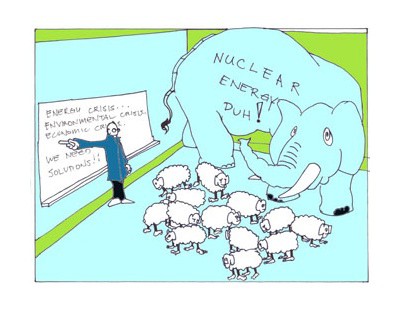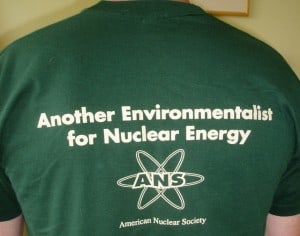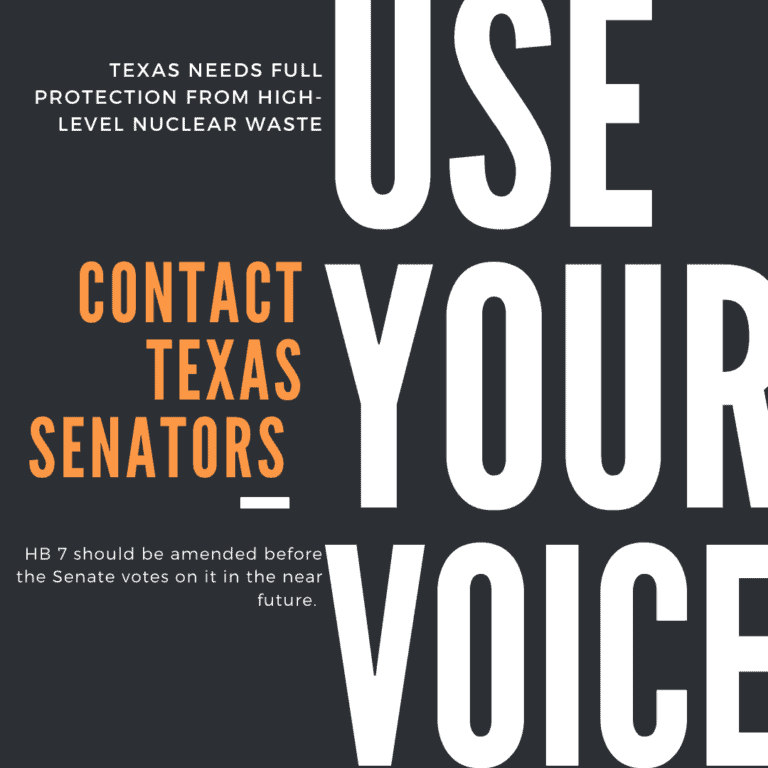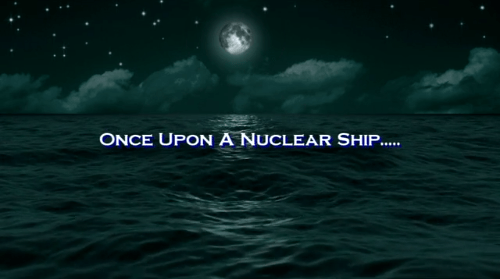Robert Stone calls Pandora’s Promise his most important film
Robert Stone calls Pandora’s Promise his most important work because it discusses our biggest collective challenge – how do we supply a growing world population with the reliable power it needs without slowing choking the Earth’s ability to support our civilization and all of its existing infrastructure. He and the people whose conversions he describes in his film have figured out that the very best answer we have available to us today is to replace as much of our current hydrocarbon consumption as possible with modern nuclear energy technology.
As a long time pronuclear environmentalist, I am happy to see that more and more thinking, caring people are reevaluating what they think they knew about nuclear energy.
One of my favorite conversation starting tee shirts is a dark green shirt emblazoned with the following bold statement on the back – “Another Environmentalist for Nuclear Energy.” It almost never fails to stimulate questions when I wear it at public meetings about nuclear energy issues. The people who favor nuclear energy read it and smile, asking where they can get one. The people who adhere to dogma and only have a superficial knowledge of nuclear energy as a memorized series of “issues” or talking points ask me what kind of environmentalist I can be if I favor nuclear energy.
My pat answer is that I am the kind of environmentalist who favors clean air, clean water and human technology designed for a minimal impact on the rest of the environment. I tell them that any power source clean enough to run inside a sealed submarine meets my standards of being gentle on the environment.
As a submariner, I was taught that our most important tactical goal was to “remain undetected”. The submariner’s mantra aligns almost perfectly with the environmental philosophy taught to backpackers on the Appalachian Trail – “leave no trace”.
Of course, humans have the ability to goof up almost any of their inventions. In part, the First Nuclear Age was driven by people who believed in the “economy of scale” as a phrase that implied that every instance of a technology needed to be as big as possible. They calculated, often with models that ignored certain diseconomies of scale, that bigger machines could produce power at a lower cost (and higher profit) per unit of electricity. They ignored the scale economies that come with series production and simplicity.
They also ignored the fact that their wonderful new technology was doing something that brought cheer to the hearts of many and great economic threats to the pocketbooks of a few very wealthy and powerful people. While most of the people I knew growing up in the 1970s thought it was great to have power plants that did not need any coal, oil or natural gas, I learned later just how much money companies that sell one, two or all three of those hydrocarbon products make each year.
Those three products supply about 85% of our current energy needs and represent a business pulling in several trillion dollars per year in revenue. One company, with less than a 4% share of the global market for oil and natural gas, recently reported that their 4th quarter 2012 revenue was $115.17 billion.
That is within 50% of the annual budget of the US Navy – including the wartime supplemental funds. Nukes have generally been blind to an important economic reality; when our technology wins sales, our hydrocarbon competitors lose money. Wealthy and politically powerful people don’t like to lose money. They don’t like people to think there are better alternatives that can reduce the demand for their flawed products. They do not mind finding and funding greenwashers or antinuclear activists that campaign against their competition.
Not surprisingly, many hydrocarbon companies love putting warm and fuzzy images of wind turbines, solar panels or algae fuel facilities into their annual reports and into their well-funded ad campaigns. Those unreliable technologies do not threaten sales of their core products. Have you ever noticed the silence of the oil and gas companies when it comes to nuclear energy – even in communications where they are trying to tell the story that they are clean energy companies, not big bad oil companies?
There is one issue that seems to always come up as the reason that people in the “Environmental Community” are taught to reject nuclear energy; they are told that the technology has an unsolvable waste issue. The former antinuclear environmentalists turned pronuclear environmentalists who are featured in Pandora’s Promise have been primarily motivated by recognizing that the truth is just the opposite.
Instead of “the waste issue” being nuclear energy’s biggest negative feature, they have realized that the hydrocarbon energy sources that compete with nuclear energy have the real intractable, massive waste problem. With nuclear energy, the material that is considered to be waste is already tiny and well contained. In addition, there are known solutions that have been proven at a greater than laboratory scale to work to reduce that waste even further while providing massive quantities of reliable, emission free power.
One of the technologies that excites the people in Pandora’s Promise is the Integral Fast Reactor, one of several reactor designs that allows an impressive increase in fuel utilization. Our current machines extract about 6,000 MW-days/tonne of mined uranium; the IFR may approach 500,000 or even 1,000,000 MW-days/tonne when it is fully developed. Higher fuel use means even less waste production.
In contrast, the hydrocarbon industry is only capable of using its massive marketing budget to insert the word “clean” in front of “coal” and “natural gas” into the public mind. Their technology, however, is actually incapable of economically and safely capturing the 30-40 billion tons of gaseous and fine particulate waste products dumped into the atmosphere every single year. A substantial portion of that waste production consists of materials that have causes far more human suffering and early death than any of the materials that have ever been released from a nuclear energy production plant.
However, the fossil fuel industry has also successfully used its marketing muscle to tag the adjective “deadly” in front of “nuclear waste”, even though the record shows few, if any human deaths associated with exposure to the waste material produced in nuclear power plants. That is not to say that the material is benign if not properly handled; it is to say that the material can be properly handled by following rather simple rules.
Stone has purposely rejected any support from the nuclear energy industry because he does not want anyone to think that he has compromised his integrity. He is probably smart to do so, but I believe there will come a time when people recognize that there are tens of thousands of people with high personal integrity that did not need a midlife conversion to realize that developing nuclear energy technology is a highly moral and rewarding way to build a useful career. Some of us experienced good teaching or early personal experiences that allowed us to see through the propaganda and take the road less traveled.
Though I have always been “Another Environmentalist for Nuclear Energy”, I welcome all converts with open arms and open books. After all, once a curious person gets past the dogma, there is an enormous and growing library of information about the technology with an even larger universe of future developments and opportunities.
Put Pandora’s Promise on your radar. Go out and see it as soon as it comes to a city near you.
PS – I have to share a little laugh with you. Try going to pandoraspromise.org and see who has purchased that domain name and redirected it to their propaganda site.





Rod,
Been there, done that where do I get that T Shirt ?
Looks like a interesting flick. It would be nice if the website for it could set up some kind of pay per view – that wasn’t too expensive and available to all. I wouldn’t mind shelling out a few buck there especially knowing a good percentage was going to an actually well read and up to date artist.
A link from the movie site that probably should be required reading:
The Great Schism in the Environmental Movement ( http://www.slate.com/articles/health_and_science/science/2012/12/modern_green_movement_eco_pragmatists_are_challenging_traditional_environmentalists.html )
Good post. Nice T-shirt too.
Rod,
I believe the burn-up number is now around 60,000 MWD/Mt. It is also important to note that the energy value of spent fuel is ~ 4 times it’s weight in gold…and it’s all owned by the government eventhough we (the rate payers) paid for it and pay to dispose of it. What a SCAM!
@John – please take another look at the units I used. 6,000 MW-days per tone of mined uranium, not per tonne of enriched fuel.
Regarding the highjacking of his copyrighted intellectual property name by the craven radiophobes using pandoraspromise.org, I think Mr. Stone has an excellent cause for legal action.
I hope he, and other nuclear organizations being routinely slandered, become more aggressive in turning this remedy back onto their tormentors.
@Atomikrabbit,
I really doubt that legal action would go anywhere. They are now considered public figures not private citizens so you are allowed to lie about them to your hearts content and no legal action is permitted. The concept of slander is nearly gone from modern society. I can’t think of a case where someone actually won when their name and ideas were twisted into strange forms.
If Stone has trademarked Pandora’s Promise, he can probably start something with the ICANN dispute resolution mechanism and get the domain re-assigned to him.
Although I was speaking of copyright infringement rather than libel, these kinds of defamation cases are routinely filed and adjudicated.
Although Engineer-Poet’s resolution is the more likely outcome, I wouldn’t mind seeing something like this going down: http://www.nytimes.com/1997/03/21/business/firm-awarded-222.7-million-in-a-libel-suit-vs-dow-jones.html
Regarding legal action against Beyond Nuclear – it would probably just be counterproductive. Ever heard of “The Streisand Effect”? That’s where you draw attention and sympathy to something or someone by being a bully (or at least perceived as being a bully), and so hurt your own cause, ultimately.
No, just keep promoting the movie, and ignore then Beyond Nuclear folks. As for their claims about the IFR and the people featured in the documentary, just present the facts to folks.
Remember, you can lead a horse to water, but you can’t make it think.
I kinda like that they did it. Typical Green dishonesty. Someone open minded and intelligent enough to seek out the film will understand what is going on and isn’t going to appreciate that kind of nonsense wasting their time.
Robert Stone is a ‘Green’. I think that is a term that has gotten a bit too general. It may feel cozy to use it, but if you want other ‘Greens’ like Stone to change their mind, it might be worth dropping this terminology and be a bit more specific.
So am I, in a way I guess. I use it now to mean the political types that associate with the political “Green” platform. ( http://www.gp.org/committees/platform/2012/ecological-sustainability.php ).
I think since they are the organized “Green” political organization they may in effect own the word, In which case id rather just toss it out with the bathwater so to speak.
“Greens” dont change their minds that I have seen. They remove themselves from that insanity. I dont look back.
There is another interview with Stone at http://youtu.be/O_zQnDeKW-E, starting about 27:00.
It is worth 12 minutes of your time, as he announces he is out of the film business and wants to do nothing now but promote the environmental benefits of atomic energy.
A candidate for the Atomic Show podcast?
Terrific !! This is the way things are going to be turned around. Environmentalists with an open mind. These are very influential people.
The Directors Note at the pandoraspromise.com website is great reading.
And, read this review of the movie by Owen Gleiberman at EW Weekly:
http://insidemovies.ew.com/2013/01/24/why-is-the-way-way-back-a-crowd-pleaser/
The first part is about another film, but read down. I would have posted the whole thing, but kind of long, and I suppose there might be copyright issues. Anyway, the review is fantastic, thoughtful and persuasive (at least that one should see the film).
Title of Gleiberman’s Review:
Sundance: What makes ‘The Way, Way Back’ a crowd-pleaser? Plus ‘Pandora’s Promise,’ a radically sane and important documentary about how nuclear power could save us
Found out about you on DNR… great show BTW.
Perhaps you can address an issue you raised here about the tremendous amount of profit companies make.
Why aren’t these companies like Exxon and BP investing in nuclear as well? Wasn’t Exxon billing themselves as an “energy” company recently rather than an “oil” company? Or where they just blowing smoke (get it)?
It seems Inevitable that there WILL be a switch away from oil/gas to nuclear, they can lead, follow or get out of the way.
@PilotBob
Thank you for the kind words.
My guess is that oil and gas companies are plagued by what Clay Christensen would describe as “the innovator’s dilemma.” They are making such enormous profits in their current business that they would be risking a great deal of money if they helped to enable nuclear energy to be more viable in the market.
A large portion of their profits is based on the perception that energy is scarce. Imagine what ExxonMobil’s quarterly income statement would look like if oil prices had just kept pace with inflation since 2000. Back then, oil was selling for less than $20 per barrel; it had been holding at that level for about 15 years. With inflation, it should be selling for less than $35 per barrel now if the scarcity perception did not exist.